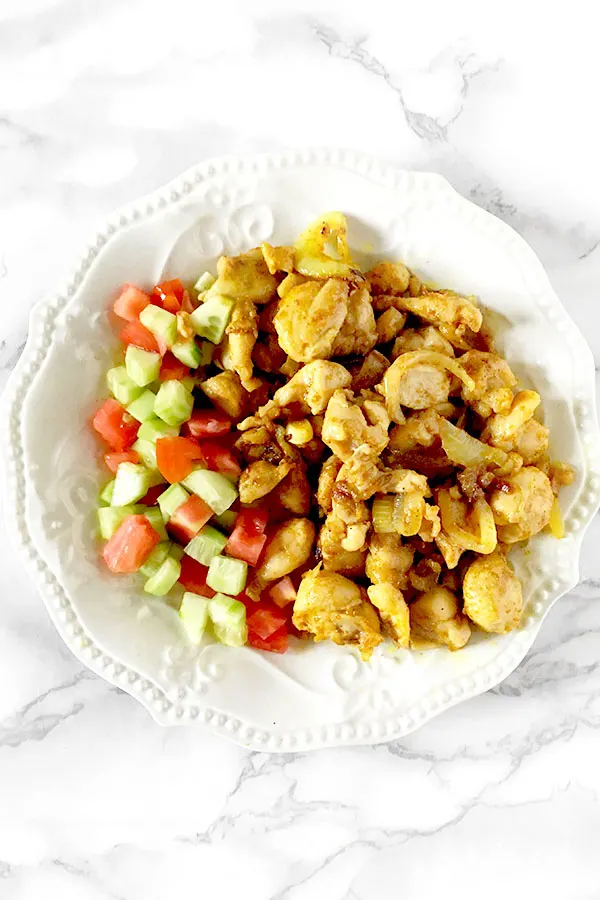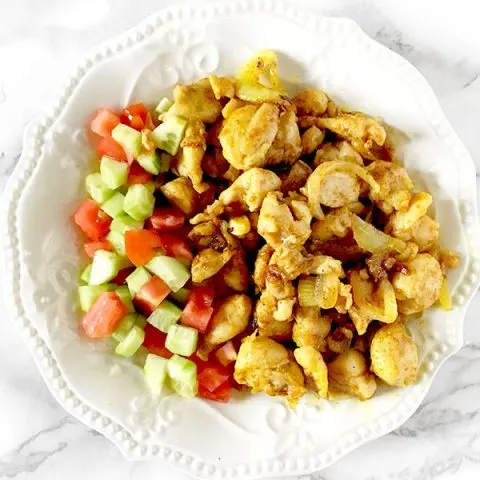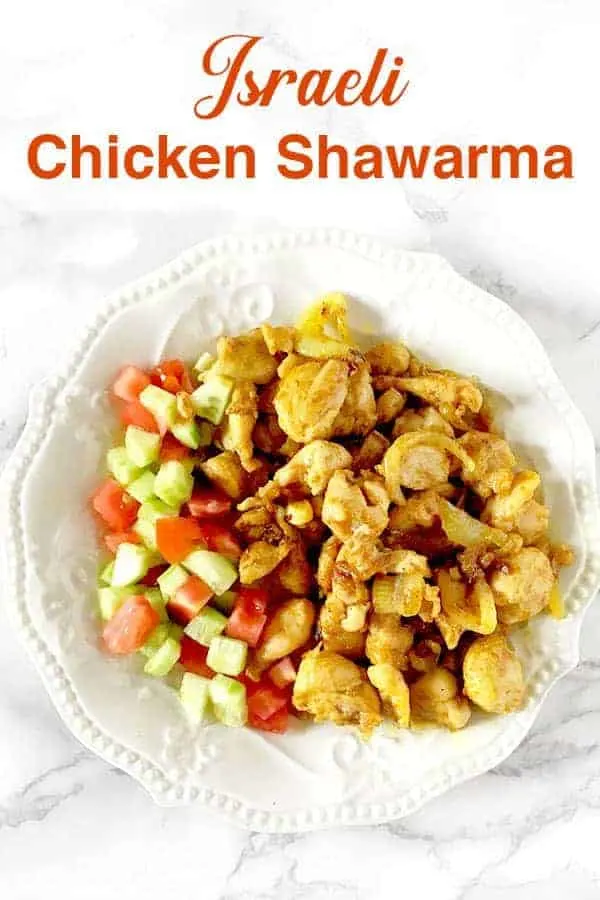Shawarma is Israel’s favorite street food along with falafel. This version has all the classic shawarma flavor but is easy to make at home. Serve with Israeli salad and mujadera or Israeli rice and beans.

In Israel, you can find a shawarma shop just about anywhere you go. In Jerusalem, you cannot walk a block in the center of town or the market without passing one.
Shawarma was originally made of lamb but today in Israel, it's usually made from chicken or turkey, though lamb shawarma and even goat shawarma are available.
In fact, the turkey version is so common that Israelis eat more turkey per capita than any other country in the world.
Due to Thanksgiving, America comes in second. However, the average Israeli eats about more than double the amount of turkey than the average American.
While in Israel shawarma is considered street food and you’d be hard pressed to find a sit down restaurant serving it, in the States things are different.
Israeli restaurants serve shawarma often as a platter rather than in a pita or wrapped in a lafa. It also is often not made using a shawarma rotisserie but in a pan or on a griddle.
This version is particularly easy to make at home because you have all the equipment you need and the chicken is cut before cooking.
It’s what you’d find labeled as “baby chicken shawarma” on a menu at an Israeli restaurant in New York.
Don’t worry, no chicks were harmed in the making of any shawarma.
The misnomer comes from the word “pargit” which someone mistranslated as a baby chicken when it’s really a pullet.
However, since all fully grown chickens on the market today are pullets, pargiot has come to mean boneless skinless chicken thigh.
Why I only use shawarma seasoning
Simply said, shawarma seasoning makes for better shawarma.
Any recipe that suggests the spices individually cannot give amounts small enough for a proper blend with subtle flavors.
That's why I only buy or make my own seasoning.
You can buy shawarma seasoning in almost any Jewish supermarket. Or, you can make your own using my recipe using easy-to-find ingredients.
My seasoning is exactly the same as those you'd find in Israeli supermarkets.
Oh, and stay away from marinades. No actual shawarma uses a marinade, only seasoning.
How to eat Shawarma
The two classic ways to eat shawarma are in a laffa or a pita.
A laffa is a Levantine flat bread similar to naan but much bigger and is not as common to find in the Western Word as pita is.
In a Pita
Street food styled shawarma is never eaten alone.
A basic version is with humus (hummus) spread on the bread, shawarma, Israeli salad, topped with fries, and techina (tahini).
Other optional additions are onions or sliced pickles to name a couple.
I don't like tomatoes, so unless they have cucumbers separate from the tomatoes (which some places have taken to doing), I often have sliced pickles instead.
On a Plate
In the States a common way to serve shawarma is as a shawarma platter. This is a plate with shawarma and either rice and fries or Israeli salad on the side.
My Mom and I always made a special request for Israeli rice and beans though which they always accommodated.
I really like this way when serving it to guests or for Shabbos dinner instead of casually in a pita, as I would during the week.
Things that do not belong with Shawarma
You may be wondering what difference it makes but I'm half Israeli and we take our shawarma seriously. We have our purists.
However, there are some things no one would put in.
This is a list of things I've happened to see in recipes that call themselves shawarma.
Dairy
First and for most is dairy is never put in a shawarma.
It doesn't matter what kind of dairy or cheese product. Dairy is never used.
I saw this in a picture online once and as an Israeli I was horrified.
Here in Israel we love cheese of all kinds but it does not belong in a shawarma.
Lemons
Lemons also do not belong anywhere near a shawarma.
That’s Greek if anything and I’d bet money that as much as Greeks love their lemons they don’t put it with their gyro.
Olives
Israelis love olives and you’ll find them served at any meze (in Hebrew it’s called salatim which means salads) as part of a sit down meal where meat is served.
However, it would never be put with a shawrama. Oh, and if they are black olives they don't even make it onto the table.
Lettuce
I’m not even sure what lettuce is used for in Israel.
I see it in stores sometimes but it's not a big thing here.
The idea of a salad with lettuce is relatively foreign concept.
It’s certainly not put in sandwiches and it would never be put in a shawarma.
Large pieces of cucumbers and tomatoes
Large pieces are never used.
It doesn't matter if they are sliced or cut into chunks, they aren't used.
Only diced cucumbers and tomatoes for an Israeli salad are used.
IS KOSHER CHICKEN BETTER?
Kosher animals are kept in better conditions than non-kosher animals due to strict kosher health requirements of the animals.
Also, the salting process used as part of the process of making meat kosher is similar to dry brining, and therefore produces a better quality meat.
While I’ve only eaten kosher meat so I cannot compare, I’ve been told by non-Jews who do not keep kosher that they’ve noticed that kosher chicken is of superior quality to cook with.
SHOULD YOU WASH CHICKEN?
According to the USDA, you should not wash meat or poultry, since water can splash bacteria up to 3 feet surrounding your sink.
A study done by Drexel University shows that it is best to move meat and poultry directly from package to pan. The heat from cooking will get rid of any bacteria that may be present.
HOW CAN I CLEAN MY CHICKEN WITHOUT WASHING IT?
If you want to clean your chicken without washing it, wipe it down with a wet paper towel.
Just make sure the paper towel doesn't touch anything else and to toss the paper towel right away.
HOW TO DEFROST CHICKEN
IN THE FRIDGE
Defrosting chicken in the fridge is the most highly recommended.
To do this, place the frozen chicken in a pan and let it thaw. Oftentimes, when chicken thaws, it releases liquids that can leak onto your fridge, so the pan is really helpful.
Chicken typically takes a full day to thaw. Once thawed, it can remain in the refrigerator for a day or two before cooking.
IN COLD WATER
Defrosting chicken in water should take two to three hours.
Submerge your sealed chicken in a pot or bowl full of cold water. Change out the water every 30 minutes or so.
Do not hot use water because it can start cooking your chicken.
Can you cook FROZEN chicken?
According to the USDA, you can cook frozen chicken. It will take 50% longer to cook, but it’s an option.
You should also cook it on a roasting rack or over vegetables so that the heat can circulate around the chicken.
CAN YOU REFREEZE RAW CHICKEN?
According to the USDA, “food thawed in the refrigerator is safe to refreeze without cooking.” However, you do lose quality when refreezing previously defrosted meat.
Every time you defrost meat, it loses moisture as it thaws, which also leads to a loss in flavor. To compensate for this, marinate the chicken to add more flavor and juice.
The USDA also says not to “refreeze any foods left outside the refrigerator longer than 2 hours; 1 hour in temperatures above 90°F.”
SHOULD YOU BRINE?
Brining actually doesn’t do anything to help poultry. In fact, it makes it soggy rather than juicy, with watered-down flavor.
Aromatic brines and stock don’t help with flavor either. This is because the salt pulls water molecules in, leaving most of the flavor behind.
DRY BRINING
A dry brine, on the other hand, loosens up muscle fibers, allowing them to retain more moisture without adding any excess liquid.
Initially, the salt draws moisture out, then it dissolves in this liquid, creating a concentrated brine, which eventually gets reabsorbed. This leads to more intensely flavored results.
An added benefit is that it also requires less space and mess than a water brine. Not to mention the fact that it allows for crispier skin.
CAN YOU DRY BRINE KOSHER chicken?
Food experts are often under the impression that kosher meat and poultry cannot be brined and dry brined.
This is because of the koshering process, which involves salting the meat. However, the process is not nearly as long as the dry brining process, and unlike a dry brine, the poultry is soaked to remove the salt.
So, since the process is different than a dry brine, it is fine and even recommended to dry brine kosher poultry and meat.
How do you dry brine chicken?
Begin by patting the chicken with paper towels. This will help the salt adhere to the chicken.
Grab pinches of kosher salt and sprinkle it over the chicken until the chicken is generously salted and evenly coated.
Place the dry-brined chicken on a rack or a plate and refrigerate it. Refrigerate chicken pieces for at least 1 hour, skinless pieces for 30 minutes to 1 hour or up to about 12 hours, and a whole chicken for 8-24 hours.
Once the waiting period is up, there is no need to rinse off the chicken. Just cook it as usual.
HOW TO STORE CHICKEN
Place cooled chicken in an airtight container or wrap in heavy-duty aluminum foil or plastic wrap. Store in the fridge for up to 4 days.
HOW TO FREEZE CHICKEN
Freeze leftovers within 3-4 days. Place cooled chicken in an airtight container or resealable freezer bag.
Freeze for up to 4-6 months. After that, it is still safe to eat, but the quality begins to degrade.
Chicken Shawarma

Easy stove-top version of classic Israeli chicken shawarma.
Ingredients
- 1 pound boneless skinless chicken thighs (450 grams), cut into cubes or thin short strips
- 1 medium onion, sliced (optional)
- 1 ½ tablespoons shawarma seasoning*
- Oil
Instructions
- Coat the pan with oil and heat.
- Lower the flame to medium. Add onions and cook until soft.
- Add chicken. Sprinkle with spices. Add a little more oil if needed.
- Stir constantly until cooked.
Notes
*It is better to use shawarma seasoning than whatever spices a recipe tells you because a good blend cannot be replicated in such small quantities. You can easily buy one in just about any Jewish supermarket or make your own shawarma seasoning.
If serving on a plate, serve with Israeli salad white rice, majadera, or rice and beans.
If serving in a pita, add hummus, Israeli salad, and top with fries and tahini or some variation of this.
Nutrition Information:
Yield:
4Serving Size:
1Amount Per Serving: Calories: 238Total Fat: 13gSaturated Fat: 3gTrans Fat: 0gUnsaturated Fat: 9gCholesterol: 141mgSodium: 305mgCarbohydrates: 3gFiber: 0gSugar: 1gProtein: 29g

Eva Lowensohn
Wednesday 18th of December 2019
Tried was delicious easy to make thanks
ElissaBeth
Wednesday 18th of December 2019
I'm glad to hear it!